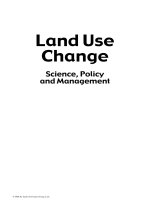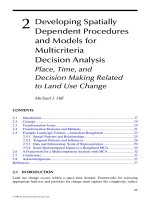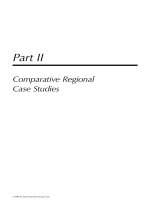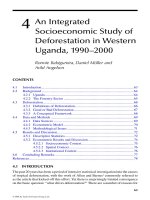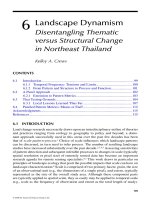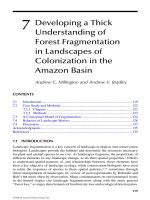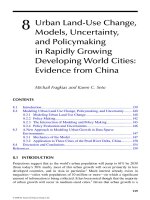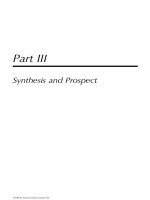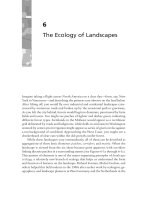Land Application of Sewage Sludge and Biosolids - Chapter 6 pdf
Bạn đang xem bản rút gọn của tài liệu. Xem và tải ngay bản đầy đủ của tài liệu tại đây (90.36 KB, 15 trang )
CHAPTER
6
Organic Chemicals
INTRODUCTION
Both natural and xenobiotic (manmade) organic compounds abound in the
universe. Many of these compounds are toxic to humans and animals. Gribble
(1994) points out that numerous chlorinated compounds are naturally produced.
These include organohalogens, numerous halogenated alcohols, ketones, carbox-
ylic acids and amides, aldehydes, epoxides and alkenes. Many of these are pro-
duced by fungi and marine algae, as well as during volcanic action, forest fires
and brush and vegetation burning. He indicates that nearly 100 different chlori-
nated, brominated and iodinated compounds have been found in an edible seaweed
favored by Hawaiians.
Our environment has been greatly contaminated by toxic organic chemicals,
primarily as a result of industrial discharges and uses of pesticides. Industrial and
manufacturing enterprises produce a myriad of organic chemicals. It has been esti-
mated that more than 5 million distinct organic compounds are registered.
Following World War II, pesticide and herbicide usage in agriculture increased
dramatically and many of the compounds used were very persistent in the environ-
ment. Kuhn and Suflita (1989) indicate that in recent years, 17 pesticides have been
found in groundwater in 23 states. In the 1960s, there was increased awareness of
the potential harmful effects of many of these organic compounds on humans, fish
and wildlife. Through soil, water, or air, many of those compounds enter the sewer
system and end up in biosolids.
Biosolids can contain toxic organic chemicals, principally as discharges from
industrial sources, but also from atmospheric deposition (Webber and Lesage, 1989;
USEPA, 1990; Jones and Sewart, 1997). Today many manufacturers and producers
of organic compounds pretreat their wastewater prior to discharging into the sewer
system. When organic compounds enter the wastewater treatment system, they can
undergo reductions or transformations prior to being deposits in biosolids that will
be applied to land. For example, chlorinated aliphatic compounds can undergo
reductive dechlorination, hydrolysis, dehydrochlorination and dihaloelimination
©2003 CRC Press LLC
(Ballapragada et al., 1998). The authors found that specific bacteria accomplished
dechlorination of several chlorinated organic compounds.
Jones and Sewart (1997) speculated that the process of potential importance
during wastewater treatment could involve (1) deposition of dioxins in the biosolids,
(2) microbial degradation during digestion, (3) volatilization of the lower-chlorinated
homologue groups and (4) possible formation of PCDD/F during the wastewater
treatment by microbial mediated reactions. This chapter does not discuss the fate of
organic compounds during wastewater treatment.
The data on organic compounds in sewage sludge and biosolids were presented
in Chapter 2, Characteristics of Sewage Sludge and Biosolids.
The organic compounds of greatest concern are:
• Toxic chlorinated compounds
• Alkylphenol ethoxylates
• Volatile organic compounds (VOCs)
• Dioxin and dioxin-like compounds
• Phthalates
• Polycyclic aromatic hydrocarbons (PAHs)
• Pesticides
The chlorinated compounds of major concern are polychlorinated biphenyls
(PCBs). It is estimated that since 1935, more than 60,000 metric tonnes have been
produced in the U.S. PCBs are very persistent and bioaccumulate. PCBs in soils
can be taken by plants (Strek and Weber, 1980; O’Conner et al., 1990).
Alkylphenol ethoxylates are nonionic surfactants. The main alkylophenols used
are nonylphenol ethoxylates. Alkylphenol ethoxylates compounds can be microbially
metabolized (Ahel et al., 1994). Nonylphenol ethoxylates are susceptible to photo-
chemical degradation.
Some of the sources of several priority pollutants are shown below:
• PCBs — electrical capacitors and transformers, paints, plastics, insecticides
• Halogenated aliphatics — fire extinguishers, refrigerants, propellants, pesticides,
solvents
• Phthalate esters — polyvinyl chloride and thermoplastics
• Ethers — solvents for polymer plastics
• Phenols — synthetic polymers, dyestuffs, pigments, pesticides, herbicides
• Polycyclic aromatic hydrocarbons — dyestuffs, pesticides, herbicides, motor fuels
and oils
• Dioxins — herbicides, pulp bleaching, emissions from waste incinerators, textiles
• Nonylphenol ethoxylates (NPEs) — pulp and paper, plastics, household cleaning
agents, pesticides and paint
Consideration must be given both to the risk from a pollutant and to the potential
for exposure. Exposure is a function of the presence of the compound in the media
in question — in this case biosolids — but also to its presence in other sources. In
fact, many times, exposure from food, air and water may greatly outweigh any
potential exposure from biosolids applied to land. Chaney et al. (1990) estimated
the risk from PCBs in sewage sludge applied to soil. They concluded that since
©2003 CRC Press LLC
sewage sludges contained very low levels of PCBs, the estimated risk level to the
Most Exposed Individuals (MEIs) was <10
–4
; low sludge PCBs and low probability
of MEIs are at <10
–7
lifetime risk.
Furthermore, since untreated sewage sludge is not permitted to be applied to
agricultural land, the additional transformation to biosolids can significantly reduce
the level of organics. Chlorinated organic compounds can be biodegraded during
anaerobic digestion (Ballapragada et al., 1998). During composting many organics
are biodegraded; heat drying will destroy or volatilize many organics; and alkaline
treatment will also transform or destroy some. There have been numerous studies
showing that composting biodegrades many toxic organic compounds (Rose and
Mercer, 1968; Deever and White, 1978; Snell Environmental Group Inc., 1982;
Epstein, 1997; Laine and Jorgensen, 1997; Cole, 1998; Potter et al., 1999).
When biosolids containing toxic organic compounds are applied to land, the
compounds can undergo numerous transformations and reactions. These can
affect their potential impact to humans, animals and the environment. The main
impact on humans and animals is through the food chain and water intake. Jones
and Sewart (1997) list four major pathways for organic contaminants transfer
into humans.
• Biosolids to soil to root crops
• Biosolids to soil to above ground crops
• Biosolids to soil to livestock ingestion to milk and animal tissues
• Biosolids to soil to groundwater to drinking water
They indicate that there are possibly other unusual and relatively minor pathways,
such as direct ingestion of soil containing biosolids.
The main objective of this chapter is to provide information on the fate and
potential impact of organic compounds in biosolids when applied to soil. Several
excellent sources of more detailed information include reviews by Jones and
Sewart (1997); Alexander (1995); Chaney et al. (1996); Sawhney and Brown
(1989); and the Final Report by the Water Environment Association of Ontario
(2001) entitled Fate and Significance of Selected Contaminants in Sewage Bio-
solids Applied to Agricultural Land Through Literature Review and Consultation
with Stakeholder Groups.
FATE OF TOXIC ORGANIC COMPOUNDS WHEN BIOSOLIDS
ARE LAND APPLIED
Soils throughout the world are contaminated with toxic organic compounds. Soil
contamination can result from atmospheric deposition, combustion of wastes, waste
disposal, spillage of industrial materials, usage of pesticides, discharges of household
chemicals and numerous other ways. For example, atmospheric deposition is the
primary means of soil contamination of PCDD/Fs, according to Jones and Sewart
(1997). They reported that soils in urban and industrial areas had higher concentra-
tions than rural soils.
©2003 CRC Press LLC
No systematic survey of dioxin soil levels has been conducted in the United
States (USEPA, 1999). Based on the examination of data from numerous projects,
USEPA reported that, for rural soils, the values ranged from one to six ppt I-TEQ
(International Toxic Equivalents). In Table 6.1, Cook and Beyea (1998) showed
levels of several organic compounds in rural North American soils.
Cook and Beyea (1998) also published data on atmospheric deposition of selected
organic compounds (see Table 6.2) and time constants for the disappearance of these
compounds (see Table 6.3). Apparently, these compounds are very persistent in soils.
When biosolids are land applied, toxic organic compounds can undergo numerous
reactions and transformations. These can affect their movement through the soil to
water resources, uptake by plants, volatilization to the atmosphere, accumulation in
soil biota and other fates. The major reactions, transformations and fate in the soil are:
• Volatilization and wind erosion
• Photodecomposition or photochemical degradation
• Foliar interception and adsorption
• Plant uptake and crop removal
• Runoff and erosion to surface waters
• Soil adsorption and desorption
• Leaching to groundwater
• Biological degradation
• Chemical decomposition
• Uptake by soil biota
Table 6.1 Level of Selected Toxic Organic Compounds in
Rural North American Soils
Compound
Number
of Samples
Geometric Mean
g Mg
–1
Standard
Deviation
PCDD/Fs* 70 0.46
¥
10
–6
5.1
PCBs 1,483 0.007 2.7
PAHs >24 0.06 4.3
* The authors quantified PCDD/Fs in terms of I-TEQ values that
were estimated from published homologue and congener data.
Source
: Cook and Beyea, 1998,
Toxicol. Environ. Chem
. 67: 27–69.
With permission.
Table 6.2 Estimated Atmospheric
Deposition of Selected Toxic
Organic Compounds
Compound
Number of
Locations
Mean
g ha
–1
yr
–1
PCDD/Fs* >4 16
¥
10
–6
PCBs 9 0.1
PAHs 6 3.5
* The authors quantified PCDD/Fs in terms of
I-TEQ values that were estimated from pub-
lished homologue and congener data.
Source
: Cook and Beyea, 1998,
Toxicol. Environ.
Chem
. 67: 27–69. With permission.
©2003 CRC Press LLC
In a review entitled “How Toxic Are Chemicals in Soil?” Alexander (1995)
indicates that the hazard and risk from toxic chemicals diminish as the compounds
persist in soil. Many of the reactions and transformations are responsible for the
diminishing of organic chemicals.
Most of the scientific literature dealing with persistence and fate of organic
chemicals pertained to pesticides. However, in recent years, considerable focus has
been given to the chlorinated compounds. These compounds are often very persistent
and remain in soils for long periods of time. The half-life of PCDD/Fs in surface
soils may be on the order of 10 years or more (Alcock et al., 1996). USEPA indicates
that there is no systematic survey of dioxin soil levels in the United States (USEPA,
1999). Rural soils values generally range from 1 to 6 ppt I-TEQ (International Toxic
Equivalents) and urban soil values range from seven to 20 I-TEQ.
Volatilization
Volatilization of organic compounds from soil can be very significant. An organic
compound in biosolids, spread on the surface or incorporated into the soil, will
partition between the gas and liquid phases to exert a vapor pressure. This vapor
may be rapidly lost. Many aromatics, such as toluene, benzene, cyclohexane and
others, are volatile. Increasing the organic matter level of soil tends to decrease the
volatilization of the hydrophobic nonpolar aromatics.
Fairbanks et al. (1987) reported that in an unamended soil, volatilization of PCBs
ranged from 5% to 31%. Volatilization of organics was the major means of loss of
14
C in unamended soil. The addition of biosolids decreased the rate of volatilization
and environmental transport. They indicated that sewage sludge can decrease plant
uptake of PCB since foliar contamination from vapor sorption is the primary source
of PCB contamination of some plants. Furthermore, the addition of sewage sludge
increased the complete degradation or detoxification of PCBs.
Jin and O’Conner (1990) found in a laboratory study that more than 80% of
toluene was volatilized from either unamended or sludge-amended soils. They indi-
cated that volatilization is a major force in toluene movement. Therefore, to reduce
possible groundwater and air pollution by toluene due to sludge application, the
sludge should be incorporated into the surface layer or deeper.
Wilson and Jones (1999) reported that volatilization was the predominant loss
process for volatile organic compounds (VOCs) from land application of biosolids.
Table 6.3 Time Constants for the Disappearance of Selected Toxic Organic Compounds
from Soils Treated with Biosolids
Compound
Number of
Years of
the Study % Loss
Estimated Number
of Years for
Disappearance Reference
PCDD/Fs 22 26–50 >100 McLachlan et al. (1996)
PCBs 0.66
30
8–33
91
2.5–5.9
14–19
Fairbanks et al. (1987)
Alcock et al. (1996)
PAHs 30
21
39-45
ca. 90
30
9
Wild et al. (1990)
Wild et al. (1991)
©2003 CRC Press LLC
The rate of loss depended on biosolids’ application rate, method of application, soil
properties and compound characteristics. When biosolids are applied to land, the
loss of VOCs, PCBs and chlorophenols (CPs) by volatilization can be important
(Wilson et al., 1997). Dioxins and furans may be volatilized and adsorbed by foliage.
Carpenter (2000) indicates that the half-lives for PCDD/Fs range from 10 to 17
years, but when residues are on the surface the half-life is considerably shorter. This
is probably due to both volatilization and photo-oxidation.
Photodecomposition
There is virtually no data on photodecomposition of organic compounds from
surface-applied biosolids. Some organic compounds in biosolids applied to the soil
surface can undergo photodecomposition. Phenolics and polynuclear compounds
can undergo such reactions when exposed to solar radiation. Usually photodecom-
position is measured as part of the total decomposition by biological and abiotic
mechanisms.
Degradation
Many bacteria, fungi and other organisms have been found to degrade organic
compounds under aerobic conditions. For example, Saber and Crawford (1985)
isolated strains of
Flavobacterium
that degraded pentachlorophenol (PCP). The
white rot fungi have been found to degrade a wide host of organic compounds. Barr
and Aust (1994) listed the environmental pollutants degraded by the white rot fungus
Phanerochaete chrysosporium
. These include:
• Chlorinated aromatic compounds
• Pentachlorophenol (PCP)
• 2,4,5-Trichlorophenoxyacetic acid
• Polychlorinated biphenyls (PCB)
• Dioxin
• Polycyclic aromatic compounds
• Benzo(a)pyrene
• Pyrene
• Anthracene
• Chrysene
• Pesticides
• 1,1,1-Trichloro-2,2-bis(4-chlorophenyl)ethane (DDT)
• Lindane
• Chlordane
• Toxaphene
Many organic compounds will degrade in the soil. This process is extremely
important as a means of removing several toxic organic compounds. There is exten-
sive literature on the degradation of pesticides in soil. Organic matter can either
©2003 CRC Press LLC
accelerate or possibly inhibit biodegradation. Guthrie and Pfaender (1998) deter-
mined that biodegradation was the main means of removing pyrene. Accelerated
biodegradation could occur through the enhancement of the microbial population
and its activity. Organic matter can also tie up compounds, thus reducing or delaying
their assimilation by the microbial population. Adding compost to soils accelerates
the degradation of toxic organic compounds. Stegmann et al. (1991), Atlas (1991),
and Hupe et al. (1996) showed that compost added to soils was effective in hydro-
carbon degradation.
Bellin et al. (1990) studied the degradation of pentachlorophenol (PCP) in
biosolids-amended soils. Pentachlorophenol is highly toxic. It has been used prima-
rily as a fungicide and insecticide in the preservation of wood. Extensive use of this
compound has resulted in contamination of soils, water, air and biosolids (Buhler
et al., 1973). DNP or 2,4-dinitrophenol is a compound toxic to animals and plants
that occurs as a waste contaminant from several industrial sources (O’Conner et al.,
1990). The authors found that it was rapidly degraded in soils and only slightly
affected by biosolids. Degradation of PCP appeared to be more favorable in high-
pH soils. Their data for the Norfolk soil suggested a first-order degradation with a
half-life of about 38 days. Wilson et al. (1997) indicated that biodegradation was a
very important process in the loss of toluene and
o-
,
m-
and
p-
xylene, PCBs and
PCPs in soil. This was not true of PCDDs/Fs.
Nonylphenol ethoxylates (NPEs) are found in soils where biosolids have been
applied. Marcomini et al. (1989) evaluated the fate of various NPEs in sludge-
amended soil. They determined that 80% of NPEs in the sludge-amended soil
degraded in the first month. There remained residual levels after 320 days. Possibly,
some of the NPEs may have leached out of the analytical zone. NPE does not appear
to significantly move through soils to groundwater (Langenkamp and Part, 2001).
Fairbanks and O’Connor (1982) showed that 84% to 89% of di (2-ethylhexyl)
phthalate (DEHP) was degraded in 146 days. Overcash (1983) indicated that the
decomposition half-life for di-
n
-butylphalate ester was approximately 80 to 180 days
and for nonionic surfactants, 300 to 600 days.
Kuhnt (1993) reported that surfactants used in domestic detergents such as LAS
and non-ionic LAE are rapidly and extensively degraded in biosolids-amended soil
and even in soils with no previous exposure to those compounds. Managas et al.
(1998) also reported complete loss of LAS from biosolids-amended soil within 98
to 336 days. Under aerobic conditions, LAS has been reported to degrade rapidly
(Litz et al., 1987; Madsen et al., 1997). Jensen (1999) concluded that the combination
of relatively rapid aerobic degradation and reduced bioavailability when biosolids
are applied likely prevents LAS from posing a threat to terrestrial ecosystems on a
long-term basis.
PLANT UPTAKE OF ORGANIC COMPOUNDS
The potential plant uptake of toxic organic compounds from biosolids-amended
soils depends on (a) the presence of the compound and its concentration in the
biosolids; (b) the chemical and physical properties of the compound; (c) reactions
©2003 CRC Press LLC
in the soil that affect its availability and (d) rate of uptake by plants. Simonich and
Hites (1995) determined that environmental factors and plant species are also impor-
tant factors. As was indicated in Chapter 2, biosolids generally contain very low
levels of toxic organic compounds. The principal concern has been with low levels
of highly persistent and toxic compounds such as PCBs, PAHs, dioxin, PCPs,
phthalates and similar compounds.
Bioconcentration factors (BCFs) are used to quantify plant contamination.
Organic chemicals can enter the plant from a contaminated soil and be translocated
in the plant through the xylem. The compound needs to be soluble, since the xylem
transports water from the roots to the leaves by transpiration. Organic compounds
can also enter through the leaves from the atmosphere and be translocated by the
phloem. These pathways are a function of (a) the chemical and physical nature of
the compound, such as lipophilicity and water solubility; (b) environmental factors
such as ambient temperature; (c) edaphic factors such as organic content of the soil;
and (d) plant species (Simonich and Hites, 1995).
Early data demonstrated that several organochlorine pesticides are adsorbed by
root crops (Lichtenstein, 1959; Lichtenstein and Schulz, 1965; Harris and Sans,
1967; Beall and Nash, 1971). Iwata and Gunther (1976) reported that carrot roots
absorbed PCBs. However, 97% of the PCBs were found in the peel, with very little
translocated in the plant tissue.
Studies on PCB uptake from biosolids-amended soils are limited. Davis et al.
(1981) showed that with Milorganite, a heat-dried biosolids product containing low
concentrations of PCBs (20 to 40 mg/kg), there was no detectable PCB in grass.
O’Connor et al. (1990) studied the uptake of PCBs by fescue, carrot and lettuce
from a highly contaminated sludge. The sludge contained 52 mg/kg of PCBs. Only
carrots were contaminated, though the PCB contamination was restricted to the peel.
The concentration of PCBs in this study was considerably higher than concentrations
of one to five mg/kg typically found in biosolids.
Ingestion by animals of plants and accumulation in animal byproducts, represent
another mechanism for a toxic organic compound to enter the food chain. Extensive
studies were done on PCB intake to tissue and milk in dairy cattle (Fries et al., 1973;
Willet, 1975). They showed that Aroclor 1254 was concentrated in milk fat.
Fries (1982) cites three means of plant contamination: direct, indirect and soil
ingestion by animals. Direct plant contamination occurs when biosolids are applied
to a crop and adheres to plant surfaces. In the case of liquid sludge application to
forage crops, the PCB intake by animals will depend on whether they are allowed
to graze shortly after application. Currently, the 503 regulations require a waiting
period of 30 days prior to grazing. However, if the forage is mowed and fed to
animals, some of the biosolids would adhere to the crop. Indirect intake by animals
depends on the root adsorption and translocation to the foliage. As indicated earlier,
scientific evidence shows that PCBs are not taken up by most plant roots and
translocated to the aboveground portions of plants. Grazing animals will ingest soil.
Fries (1982) found that grazing dairy cattle’s ingested soil represents as much as
14% of their dry-matter diet. Thus, biosolids containing toxic organics, when left
on the soil surface, can be ingested along with the soil. Incorporating biosolids into
the soil is the best way to reduce animal exposure.
©2003 CRC Press LLC
PAHs are ubiquitous and are found in soils and foliage due to atmospheric
deposition (Wild and Jones, 1992). Plant uptake through the roots is limited since
organic matter adsorbs them. The organic matter in biosolids increases the adsorption
potential, thus making them less available to plants (Ryan et al., 1988). Furthermore,
since PAHs are lipophilic/hydrophobic compounds, they tend to be more greatly
adsorbed by soil organic matter.
Wild and Jones (1992) suggest that root uptake may be enhanced by the presence
of surfactants in biosolids and that adsorption onto root surfaces can be an important
process in root uptake. They analyzed carrot foliage, root peels and root cores for
15 PAHs. Neither foliage nor root cores were affected by anaerobically digested
biosolids. Carrot root peel PAH concentrations increased to a plateau with increasing
soil PAH levels.
Pentachlorophenol (PCP), the compound used as a wood preservative, has con-
taminated water, air, food and sediment over the years (Bevenue and Beckman, 1967;
Buhler et al., 1973). Bellin and O’Connor (1990) evaluated the uptake of PCP by
tall fescue, lettuce, carrot and chili pepper from biosolids-amended soil. They found
minimal plant uptake of intact PCP in fescue and lettuce and none in carrot or chile
plants. Plant dry wt/initial soil concentration (BCF values) for the lettuce and fescue
were <0.01. They found that degradation in the soil was rapid and that minimal
contamination could occur in the field.
Chlorobenzenes (CBs) can be found in biosolids. They are lipophilic and volatile
and therefore can be taken up by both the roots and foliage (USEPA, 1985). Overcash
et al. (1986) indicated that monochlorobenzene and 1,4-dichlorobenzene reached
the highest BCFs into crops grown on sludge-amended soil. Wang and Jones (1994)
studied the uptake of CBs by carrots grown in soil treated with different rates of
sewage sludge. Both carrot foliage and roots took up CBs from all the soil treatments.
There was no evidence that the CBs were translocated from the roots to the tops.
There was some penetration by dichlorobenzene from the peel to the core.
Phthalates are found in sludge and biosolids. The most common compound is
di-(2-ethylhexyl) phthalate (DEHP). Studies prior to 1990 investigated the uptake
of DEHP from soil (Overcash et al., 1986). DEHP is strongly adsorbed to the soil
organic matter; therefore the presence of biosolids may decrease DEHP availability
and reduce uptake by plants (Aranda et al., 1989). The authors studied the uptake
of DEHP from sludge-amended soil by three food chain crops — lettuce, carrot
and chili pepper — as well as tall fescue. Intact DEHP was not detected in any
of the plants. The low bioconcentration factors suggested very little uptake of
DEHP.
Since dioxins are considered highly toxic and are ubiquitous as a result of
atmospheric deposition, recent attention has been focused on potential uptake by
plants (Hülster et al., 1994; Welsch-Pausch et al., 1995). Jones and Sewart (1997)
reviewed the uptake of PCDD/F by plants and the various pathways. They state that
PCDD/F concentration in the aboveground portion of plants is controlled by foliar
uptake and is virtually unaffected by changes in soil concentrations. Jones and Sewart
(1997) and Wild et al. (1994) conclude that the influence of biosolids’ application
on PCDD/F concentration on aboveground plant tissues can be ignored in the
pathway analysis.
©2003 CRC Press LLC
Hülster et al. (1994) reported that the fruits of zucchini had higher concentrations
of PCDD/PCDF than other fruits and vegetables. They indicated that uptake by
zucchini and pumpkin was principally from the roots with subsequent translocation
to the shoots and fruit. However, as Jones and Sewart (1997) indicate, these crops
make up a very small amount of our diet and therefore are not very significant as a
human exposure pathway.
Cucumber plants were mainly contaminated by atmospheric deposition. In a
study with Welsh ray grass, an important food chain plant, Welsch-Pausch et al.
(1995) did not find that soil-related uptake was important in plant uptake of
PCDD/PCDFs. Dry gaseous deposition was the principal pathway of contamination.
Table 6.4 presents some examples of organic compounds and organisms that
degrade them under aerobic conditions. Thus, over time, many of the persistent
organic compounds will biodegrade in the soil.
O’Connor (1998) found three factors that reduce the potential for plant contam-
ination: low concentration of toxic organic compounds in biosolids-amended soil;
Table 6.4 Examples of Organic Compounds and the Organisms That Degrade
Them Under Aerobic Conditions
Organic Compound Organism Environment
2-Chlorobenzoic acid
Pseudomonas
Aerobic, Soil
4-Chlorobenzoic acid
Arthobacter
Aerobic
3,5-Dichlorobenzoic acid
Pseudomonas
Aerobic
3-Chlorobenzene
Pseudomonas
Aerobic
1,4-Dichlorobenzene
Pseudomonas
Aerobic
1,4-Dichlorobenzene chlorobenzene
Alcaligenes
Aerobic
3-Chlorophenol
Nocardia
Aerobic
4-Chlorophenol
Mycobacterium
Alcaligenes
Flavobacter
Aerobic
Pentachlorophenol (PCP)
Arthrobacter
Flavobacter
Pseudomonas
Coryneform
Soil
Aerobic
Aerobic
Aerobic
2,4-Dichlorophenoxyacetic acid (2,4-D)
Pseudomonas
Azobacter
Soil
Aerobic
2,4,5-Trichlorophenoxacetic acid (2,4,5-T)
Pseudomonas
Soil
1,1,1-Trichloro-2,2-bis(
p
-chlorophenol)ethane
(DDT)
Escherica
Pseudomonas
Aerobacter
Clostridium
Proteus
Fusarium
Mucor
Cylindrotheca
Nocardia
Streptomycetes
Phanerochaete
Aerobic
Polychlorobiphenyl (PCB)
Alcaligenes
Acintobacter
Pseudomonas
Aerobic, soil
Aerobic
Soil
Source:
Boyle, 1989,
J. Environ. Qual
. 18(4): 395–402. With permission.
©2003 CRC Press LLC
strong adsorption of toxic organics to soil or biosolids; and loss of toxic organics
from soil through degradation.
Thus, O’Connor (1998) and Chaney et al. (1996) concluded that the potential
uptake of biosolids–borne and compost-borne toxic organics is small. Furthermore,
toxic organic compounds are very large molecules; therefore, with the exception of
some root crops, they are not taken up by plants and translocated to the edible
portion. Also, toxic organics may be metabolized within the plant. Jacobs et al.
(1987) did not find any phytotoxic effects of organic pollutants when biosolids were
land applied.
CONCLUSION
Both natural and xenobiotic (manmade) organic compounds abound in the uni-
verse. Many of these compounds are toxic to humans and animals. When organic
compounds in biosolids are land applied, they may undergo numerous reactions and
transformations in the soil. Surface application of biosolids can result in volatiliza-
tion and photochemical degradation. In the soil the compounds may be chemically
decomposed, adsorbed on soil particles, biodegraded, or move through the soil. Plant
uptake of organic chemicals is minimal.
Foliar interception and adsorption can also occur primarily from atmospheric
deposition. Soil biota may take up organic chemicals. Soil erosion and runoff can
contaminate water courses. The relative risk from organic chemicals in biosolids has
been shown to be minimal as a result of their relative low levels and their many
transformations, especially biological degradation.
The Water Environment Association of Ontario 2001 in its final report entitled,
“Fate and Significance of Selected Contaminants in Sewage Biosolids Applied to
Agricultural Land Through Literature Review and Consultation with Stakeholder
Groups” provided a synopsis of the properties, occurrence, fate and transfer of the
principal organic contaminant groups found in sludge and biosolids. The information
was based on a paper by Smith (1996).
REFERENCES
Ahel, M., D. Hrsak and W. Giger, 1994, Aerobic transformation of short-chain alkylphenol
polyethoxylates by mixed bacterial cultures,
Arch. Environ. Contam. Toxicol
. 26:
540–548.
Alcock, R.E., J. Bacon, R.D. Bardgett, A.J. Beck, P.M. Hagarth, R.G.M. Lee, C.A. Parker
and K.C. Lones, 1996, Persistence and fate of PCBs in sewage sludge agricultural
soil,
Environ. Pollut.
93: 83–92.
Alexander, M, 1995, How toxic are toxic chemicals in soil?
Environ. Sci. Technol
. 29(11):
2713–2717.
Aranda, J.M., G.A. O’Conner and G.A. Eiceman, 1989, Effects of sewage sludge on di-(2-
ethylhexyl)phthalate uptake by plants,
J. Environ. Qual.
18: 45–50.
Atlas, R.M., 1991, Bioremediation of fossil fuel contaminated soils, p. 15, in R.E. Hinchee
and R.F. Olfenbuttel (Eds.),
In Situ Bioremediation
, Battelle, Columbus, OH.
©2003 CRC Press LLC
Ballapragada, B., H.D. Stensel, J.F. Ferguson, V.S. Magar and J.A. Puhakka, 1998, Toxic
chlorinated compounds: Fate and biodegradation in anaerobic digestion, Water Envi-
ronment Research Foundation, Project 91-TFT-3, Alexandria, VA.
Barr, D.P. and S.D. Aust, 1994, Mechanisms white rot fungi use to degrade pollutants,
Environ.
Sci. Technol
. 28(2): 78A–87A.
Beall, M.L. and R.G. Nash, 1971, Organochlorine insecticide residues in soybean plant tops:
Root vs. vapor sorption,
Agron. J
. 63: 460–464.
Bellin, C.A., G.A. O’Conner and Y. Jin, 1990, Sorption and degradation of pentachlorophenol
in sludge amended soil,
J. Environ. Qual.
19: 603–608.
Bevenue, A. and H. Beckman, 1967, Pentachlorophenol: A discussion of its properties and
its occurrence as a residue in human and animal tissues,
Res. Rev.
19: 83–144.
Boyle, M., 1989, The environmental microbiology of chlorinated aromatic decomposition,
J.
Environ. Qual.
18(4): 395–402.
Buhler, D.R., M.E. Rassmusson and H.S. Nakaue, 1973, Occurrence of hexachlorobenzene
and pentachlorophenol in sewage sludge and water,
Environ. Sci. Technol
. 7: 929–934.
Carpenter, A., 2000, Dioxin in organic residues, 14th Annual Residuals and Biosolids Man-
agement Conference, Boston, Water Environment Research Foundation, Alexandria,
VA .
Chaney, R.L., J.A. Ryan and G.A. O’Conner, 1990, Risk assessment for organic micropol-
lutants,
Proc. EEC Symp. Treatment and Use of Sewage Sludge and Liquid Agricul-
tural Wastes
, Athens, Greece.
Chaney, R.L., J.A. Ryan and G.A. O’Connor, 1996, Organic contaminants in municipal
biosolids: Risk assessment, quantitative pathway analysis and current research prior-
ities,
Sci. Total Environ
. 185(1–3): 187–216.
Cole, M.A., 1998, Bioremediation of soils contaminated with toxic organic compounds, pp.
175–194, S. Brown, J.S. Angle and L. Jacobs (Eds.),
Beneficial Co-utilization of
Agricultural, Municipal and Industrial By–products
, Kluwer Academic, Dordrecht,
Netherlands.
Cook, J. and J. Beyea, 1998, Potential toxic and carcinogenic chemical contaminants in
source–separated municipal solid waste composts: Review of available data and
recommendations,
Toxicol. Environ. Chem
. 67: 27–69.
Davis, R.D., J.L. Pyle, J.H. Skillings and N.D. Danielson, 1981, Uptake of polychlorobiphe-
nyls present in trace amounts in dried municipal sewage sludge through an old field
ecosystem,
Bull. Environ. Contam. Toxicol.
27: 689–694.
Deever, W.R. and R.C. White, 1978, Composting petroleum refinery sludges, Texaco, Inc.,
Port Arthur, TX.
Epstein, E., 1997,
The Science of Composting
, Technomic, Lancaster, PA.
Fairbanks, B.C. and G.A. O’Conner, 1982, Fate of toxic organics in sludge–amended soils.
Proc. National Conference on Composting of Municipal and Industrial Sludges,
Washington, D.C
.
, Hazardous Materials Control Research Institute.
Fairbanks, B.C., G.A. O’Conner and S.E. Smith, 1987, Mineralization and volatilization of
polychlorinated biphenyls in sludge-amended soil,
J. Environ. Qual.
16(1): 18–25.
Fries, G.F., 1982, Potential polychlorinated biphenyl residues in animal products from appli-
cation of contaminated sewage sludges to land,
J. Environ. Qual.
11 (1): 14–20.
Fries, G.F., G.S. Marrow and C.H. Gordon, 1973, Long–term studies of residue retention and
excretions by cows fed polychlorinated biphenyl (Aroclor 1254),
J. Agric. Food Chem
.
21: 117–121.
Gribble, G.W., 1994, The natural production of chlorinated compounds,
Environ. Sci. Technol
.
28(7): 310A–319A.
©2003 CRC Press LLC
Guthrie, E.A. and F.K. Pfaender, 1998, Reduced pyrene bioavailability in microbially active
soils,
Environ. Sci. Technol
. 32: 501–508.
Harris, C.R. and W.W. Sans, 1967, Absorption of organochlorine insecticide residues from
agricultural soils by root crops,
J. Agric. Food Chem.
15 (861).
Hülster, A., J.F. Muller and H. Marschner, 1994, Soil–plant transfer of polychlorinated
dibenzo-p-dioxins and dibenzofurans to vegetables of the cucumber family (Cucur-
biataceae),
Environ. Sci. Technol
. 28: 1110–1115.
Hupe, K., J.C. Luth, J. Heerenklage and R. Stegmann, 1996, Enhancement of the biological
degradation of contaminated soils by compost addition, pp. 913–923, M. de Bartoldi,
P. Sequi, B. Lemmes and T. Papi (Eds.),
The Science of Composting
, Blackie Aca-
demic and Professional, London.
Iwata, Y. and F.A. Gunther, 1976, Translocation of the polychlorinated biphenyl aroclor 1254
from soil into carrots under field conditions,
Arch. Environ. Contam
. 4: 44–59.
Jacobs, L.W., G.A. O’Conner, M.R. Overcash, M.J. Zebeck and P. Rygwiecz, 1987, Effects
of trace organics in sewage sludges on soil–plant systems and assessing their risks
to humans, pp. 101–143, A.L. Page et al., (Eds.),
Land Application of Sludge —
Health Effects
, Lewis Publishers, Chelsea, MI.
Jensen, J., 1999, Fate and effects of linear alkylbenzene sulphonates (LAS) in the terrestrial
environment,
Sci. Total Environ
., 226: 93–111.
Jin, Y. and G.A. O’Conner, 1990, Behavior of toluene added to sludge-amended soils,
J.
Environ. Qual.
19: 573–579.
Jones, K.C. and A.P. Sewart, 1997, Dioxins and furans in sewage sludges: A review of their
occurrence and sources in sludge and of their environmental fate, behavior and
significance in sludge-amended agricultural systems,
Crit. Rev. Environ. Sci. Technol
.
27(1): 1–85.
Laine, M.M. and K.S. Jorgensen, 1997, Effective and safe composting of chlorophenol–con-
taminated soil in pilot scale,
Environ. Sci. Technol
. 31(2): 371–378.
Langenkamp, H. and P. Part, 2001, Organic constituents in sewage sludge for agricultural
use, European Commission Joint Research Centre, Institute for Environmental and
Sustainability, Soil and Waste Unit.
Lichtenstein, E.P., 1959, Adsorption of some chlorinated hydrocarbon insecticides from soils
into various crops,
J. Agric. Food Chem.
7: 430.
Lichtenstein, E.P. and K.R. Schulz, 1965, Residues of aldrin and heptachlor in soils and their
translocation into various crops,
J. Agric. Food Chem
. 13: 57.
Litz, N., H.W. Doring, M. Thiele and H.P. Blume, 1987, The behavior of LAS in different
soils: A comparison between field and laboratory studies.
Ecotoxicol. Environ. Safety
14: 103–116.
Kuhn, E.P. and J.M. Suflita, 1989, Dehalogenation of pesticides by anaerobic microorganisms
in soil and groundwater — a review, B.L. Sawhney and K. Brown (Eds.),
Reactions
and Movement of Organic Chemicals in Soils
, SSSA Special Pub. No. 22, Soil Science
Society of America, Madison, WI.
Kuhnt, G., 1993, Behavior and fate of surfactants in soil,
Environ. Toxicol. Chem
. 12:
1813–1820.
Madsen, T., P. Kristensen, L. Samso-Petersen, J. Torslov and J.O. Rasmussen, 1997, Appli-
cation of sludge on farmland — quality objectives, level of contamination and envi-
ronmental risk assessment, Specialty Conference on Management and Fate of Toxic
Organics in Sludge Applied to Land, Copenhagen.
Mangas, E., M.T. Vaquero, L. Comellas and F. Broto-Puig, 1998, Analysis and fate of aliphatic
hydrocarbons, linear alkylbenzenes, polychlorinated biphenyls and polycyclic aro-
matic hydrocarbons in sewage sludge-amended soils,
Chemosphere
1: 61–73.
©2003 CRC Press LLC
Marcomini, A., P.D. Capel, T. Lichtensteiger, P.H. Brunner and W. Giger, 1989, Behavior of
aromatic surfactants and PCBs in sludge-treated soils and landfills,
J. Environ. Qual.
18: 523–528.
McLachlan, M.S., A.P. Sewart, J.R. Bacon and K.C. Jones, 1996, Persistence of PCDD/Fs in
a sludge-amended soil,
Environ. Sci. Technol
. 30: 2567.
O’Connor, G.A., 1998, Fate and potential of xenobiotics, pp. 203–217, S. Brown, J.S. Angle
and L. Jacobs (Ed.),
Beneficial Co-utilization of Agricultural, Municipal and Indus-
trial By-products
, Kluwer Academic Publishers, Dordrecht, Netherlands.
O’Connor, G.A., D. Kiehl, G.A. Eiceman and J.A. Ryan, 1990, Plant uptake of sludge–borne
PCBs,
J. Environ. Qual.
19: 113–118.
Overcash, M.R., 1983, Land treatment of municipal effluent and sludge: Specific organic
compounds, Workshop on Utilization of Municipal Wastewater and Sludge on Land,
U.S. Environmental Protection Agency, U.S. Army Corps of Engineers, USDA Coop-
erative State Research Service, National Science Foundation, University of Califor-
nia–Kearney Foundation of Soil Science, Denver, CO.
Overcash, M.R., J.B. Weber and W. Tucker, 1986, Toxic and priority organics in municipal
sludge land treatment systems, Rep. No. USEPA Grant No. CR806421, U.S. Envi-
ronmental Protection Agency, Cincinnati, OH.
Potter, C.L., J.A. Glaser, L.W. Chang, J.R. Meier, M.A. Dosani and R.F. Herrmann, 1999,
Degradation of polynuclear aromatic hydrocarbons under bench-scale compost con-
ditions,
Environ. Sci. Technol.
33(10): 1717–1725.
Rose, W.W. and W.A. Mercer, 1968, Fate of insecticides in composted agricultural wastes,
National Canners Association, Washington, D.C.
Ryan, J.A., R.M. Bell, J.M. Davidson and G.A. O’Conner, 1988, Plant uptake of nonionic
organic chemicals from soils,
Chemosphere
17: 2299–2323.
Saber, D.L. and R.L. Crawford, 1985, Isolation and characterization of
Flavobacterium
strains
that degrade pentachlorophenol,
Appl. Environ. Microbiol
. 50: 1512–1518.
Sawhney, B.L. and K. Brown, 1989,
Reactions and Movement of Organic Chemicals in Soils
,
SSSA Special Pub. No. 2, Soil Science Society of America, American Society of
Agronomy, Madison, WI.
Simonich, S.L. and R.A. Hites, 1995, Organic pollutant accumulation in vegetation,
Environ.
Sci. Technol
. 29(12): 2905–2914.
Smith, S.R., 1996,
Agricultural Recycling of Sewage Sludge and the Environment,
CAB
International, Wallingford, U.K.
Snell Environmental Group, I., 1982, Rate of biodegradation of toxic organic compounds
while in contact with organics which are actively composting, National Science
Foundation, PB84–193150, Washington, D.C.
Strek, H.J. and J.B. Weber, 1980, Adsorption and translocation of polychlorinated biphenyls
(PCBs) by weeds,
Proc. Sci. Soc
. 33: 226–232.
Stegmann, R., S. Lotter and J. Heerenklage, 1991, Biological treatment of oil-contaminated
soils in bioreactors, pp. 118–208, R.E. Hinchee and R. F. Olfenbuttel (Eds.),
On–Site
Bioreclamation
, Battelle, Columbus, OH.
USEPA, 1985, Health Assessment Document for Chlorinated Benzenes, U.S. Environmental
Protection Agency, Office of Research and Development, Office of Environmental
Assessment, EPA-600/8-84-015F, Washington, D.C.
USEPA, 1985, Summary of Environmental Profiles and Hazard Indices for Constituents of
Municipal Sludge, Office of Water Regulations and Standards, Wastewater Solids
Criteria Branch, Washington, D.C.
©2003 CRC Press LLC
USEPA, 1990, National sewage sludge survey: Availability of information and data and
anticipated impacts on proposed regulations, U.S. Environmental Protection Agency,
Fed. Reg
. 55: 47210–47283, Washington, D.C.
USEPA, 1999, Dioxin Fact Sheet, U.S. Environmental Protection Agency, Washington, D.C.
Wang, M. and K.C. Jones, 1994, Uptake of chlorobenzenes by carrots from spiked and sewage-
sludge-amended soil,
Environ. Sci. Technol
. 28(7): 1260–1267.
Webber, M.D. and S. Lesage, 1989, Organic contaminants in Canadian municipal sludges,
Waste Manage. Res
. 7: 63–82.
Welsch-Pausch, K., M.S. McLachlan and G. Umlauf, 1995, Determination of the principal
pathways of polychlorinated dibenzo-
p
-dioxins and dibenzofurans to
Lolium multi-
florum
(Welsh ray grass),
Environ. Sci. Technol.
29(4): 1090–1099.
Wild, S.R. and K.C. Jones, 1992, Polynuclear aromatic hydrocarbon uptake by carrots grown
in sludge–amended soil,
J. Environ. Qual.
21: 217–225.
Wild, S.R., S.K. Waterhouse, S.P. McGrath and K.C. Jones, 1990, Organic contaminants in
an agricultural soil with a known history of sewage sludge amendments: Polynuclear
aromatic hydrocarbons,
Environ. Sci. Technol.
24: 1706–1712.
Wild, S.R., J.P. Obbard, C.I. Munn, M.L. Berrow and K.C. Jones, 1991, The long-term
persistence of polynuclear aromatic hydrocarbons (PAHs) in an agricultural soil
amended with metal–contaminated sewage sludges,
Sci. Total Environ
. 101: 235–253.
Wild, S.R., S.J. Harrad and K.C. Jones, 1994, The influence of sewage sludge applications to
agricultural land on human exposure to polychlorinated dibenzo-p-dioxins and -furans
(PCDFs),
Environ. Pollut
. 83: 357–369.
Willett, L.B., 1975, Excretory behavior of polychlorinated biphenyls in lactating cows fed
normal and thyroprotein containing rations,
J. Dairy Sci.
58: 765.
Wilson, S.C., RE. Alocock, A.P. Sewart and K.C. Jones, 1997, Persistence of organic con-
taminants in sewage sludge-amended soil: A field experiment,
J. Environ. Qual.
26:
1467–1477.
Wilson, S.C. and K.C. Jones, 1999, Volatile organic compound losses from sewage sludge-
amended soils,
J. Environ. Qual.
28: 1145–1153.
©2003 CRC Press LLC
